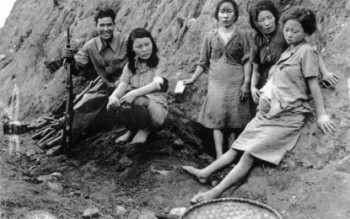Uncovered Atrocities: Korean Comfort Women
Like a wound that keeps festering, the “Korean comfort women “is an issue that refuses to die down and seek closure. Yet, more than two decades ago, its Indonesian and Philippine counterparts had reached a resolution that was satisfactory to all parties involved. Why not South Korea? The conflicting stories about the issue and the stands of the leaders of South Korea and Japan are as complicated as the testimonies of the comfort women about their experiences. Taking a step back into history may yield a clearer picture of the persistent discord between the two countries.
The Korean Comfort Women Revisited
After Japan won the Russo-Japanese War in 1904-1905, the Korean Peninsula became part of the country as adopted in the Japan-Korea Annexation Treaty of 1910. Japanese men and soldiers began going to Korea, bringing along Japanese women to pleasure them. Korean women, seeing themselves as now belonging to Japan and wanting to express their nationalist sentiments, followed suit. Thus was the ground laid for what is now known as the Korean comfort women. In the 1930s, the Japanese military created the first comfort stations in Manchuria to provide sexual services for their troops, prevent rape and the spread of sexually transmitted diseases. As Japan advanced into the other Southeast Asian countries, comfort stations were also put up in those places.
The Comfort Women of World War II
During World War II, the Korean government of the Showa regime built their own comfort houses for the military. The women were used by both Korean and Japanese soldiers. But comfort women in other Asian nations also existed. The women from China, Taiwan, Indonesia, Philippines, the Netherlands and Australia were coerced into prostitution by the soldiers. These women were subjected to the brutality of the military. They were tortured and raped and forced to have sex daily with several soldiers. Those who got pregnant were expelled.
The Interagency Working Group (IWG) that then US President Bill Clinton formed to gather documents on the war crimes of WWII revealed the atrocities committed by the Nazis and was extended to include the Japanese military’s coercion of comfort women from the Asia Pacific countries, namely Korea, China, Taiwan, Dutch East Indies (now Indonesia,) Philippines and Malaysia.
But in Korea, the situation wasn’t as dire. Korean women thought of themselves as Japanese citizens; hence, they thought that providing sex for the Japanese and Korean military was a patriotic act worthy of merit. They were treated well and went out openly with the officers and other military personnel. The relationship between many of these women and men from the Japanese Army was real and some even ended in marriage. Among the Koreans who fought in the Japanese Army and who availed themselves of the comfort houses was former president Park Chung-hee, father of the current president Park Geun-hye.
However, it cannot be denied that there were Korean teenage girls who were forced into prostitution and made to serve the Japanese Imperial Army. The Japanese had commissioned Koreans to act as brokers and recruit more women to the comfort houses. These Korean brokers went to the impoverished areas and convinced the parents to sell their daughters for a few hundred won. The girls were promised work in factories and as nurses abroad but ended up as comfort women for the Korean and lower-ranked Japanese soldiers. They were kept in brothels owned by the Korean brokers who maltreated and exploited them for money. In the Collection of Testimonies (Korea Chongshindae Research Institute, 1993), the women detailed their experiences of leaving their native country for Japan in the hope of escaping poverty, being tricked by unscrupulous Korean brokers, the sexual violence they went through and failed marriages due to their inability to bear children as a result of damaged reproductive organs. But the researchers filtered their testimonies and amended any statement that was deemed not complimentary to South Korea.
As confirmation of the matter about Korean brokers and brothel owners, a diary of a Korean comfort station manager was recently found. In it, he mentions the names of the owners of the Korean comfort houses. Their names sounded Japanese although they were actually ethnic Koreans. He also wrote that whenever more comfort women were needed, the owners would go back to their native Korea to recruit more girls. This information, carried in an article by Professor Ahn Byong Jik of Seoul University, shows that the Japanese had little or no participation in the recruitment of the women from Korea. The practice of violence and coercion against the comfort women was not condoned by the high Japanese military officers and those who committed the acts (Japanese and Korean soldiers) were court-martialed and executed.
The Comfort Women of Korea – Used by the United States and Korean Military
With Japan’s defeat in WWII, Korea gained its independence but the plight of the Korean comfort women did not end. The Korean War that lasted from 1950 – 1953 saw the division of Korea into the north and south. The United States sent American troops to back South Korea and the government, profuse with its gratitude for the US aid, gave its girls and women to the Americans to satisfy their sexual needs. Many of these women came from the rural areas and belonged to the lower socio-economic class. Lured by promises of jobs and a better life post-war, they accepted the offers. But instead of jobs in factories, they became comfort women for the US and South Korean armies and stayed in government-sanctioned brothels. To soften the blow, they were called patriots for their service to the country. A truce between the north and south ended the fighting but technically, the war was still on and because of the ever-present threats from North Korea, thousands of American soldiers remained in South Korea. Hence, the prostitution continued.
Then, in June 2014, 122 Korean women filed a suit against their government for allowing and encouraging them to become comfort women for the US troops left behind after the Korean War. South Korea was in a military dictatorship at that time and the country was very poor. The government thought they had to keep the Americans happy so they would stay and protect South Korea. These women claimed they were made sex slaves and had regular health checkups to ensure their fitness for the foreigners. To this day, many of them still live on the outskirts of the military bases, struggling to make a living in spite of their old age and scorned by society. The suit, filed in Seoul Central District Court, asks for an official apology, payment of 10 million won for each woman and an investigation of the ongoing prostitution in the areas where US military were assigned. Ha Ju-hee, one of the lawyers for the women, said that the country has an obligation to compensate them for the pain they endured and for their alleged service to the country through their sexual services. The government has countered that the women have no proof of their claim. Prostitution is illegal in South Korea and the government understandably would never admit to their wrongdoings. No representative for the US military in that nation was present in the first hearing but when asked, the United States Forces Korea gave a non-response, saying it will not tolerate prostitution and human trafficking.
Korea’s Comfort Women Seek Redress
The actions of the 122 comfort women are quite bold, considering that they will certainly suffer at the hands of the Chong Dae Hyup, an organization believed to be run by North Korea and intent on discrediting Japan. It was this same organization that prevented these comfort women from accepting Japan’s aid coursed through the Asian Women’s Fund.
The AWF was established in 1995 with the sole purpose of apologizing to the comfort women of the different countries and giving them compensation. Aware that the San Francisco Peace Treaty had already settled the matter, the AWF was funded by donations from private institutions and individuals and partly the government money. It was dissolved in March 2007 after completion of its mission, except for South Korea which, through its officials and the powerful Chong Dae Hyup, stubbornly forbade its women from accepting the offer.
At present, the issue has become highly politicized. In the Western world, Japan has long been perceived as the tormentor and South Korea as the victim. But also recently discovered are aberrations to the truth:
1. The Korean comfort women numbered 200,000?
The truth: The number 200,000 referred to the teenage girls who were recruited to become factory workers. Of them, approximately 150,000 were Japanese and 50,000 were Koreans. It was Asahi Shimbun, a left-wing Japanese newspaper that wrongly spread the inaccurate information. The Asahi based their report from a book written by Seiji Yoshida, a former war official who claimed he helped in the recruitment of the women from Jeju Island. Yoshida’s distortion of the truth was to make his book sell. But historians disproved Yoshida’s information and the newspaper was forced to retract its statements. Elderly people in Jeju Island also could not recall that many girls being forcibly taken by the Japanese Army. The actual number of comfort women from South Korea is anywhere from 20,000 to 70,000.
2. The women were forcibly taken and coerced by the Japanese military to become comfort women.
The truth: Testimonies of comfort women from Korea revealed that they were not forced to have sex against their will. It must be remembered that Korea at that time was part of Japan; hence, their women felt it was their duty to serve the soldiers fighting for their country.
Another truth that came out was that the Japanese commissioned Korean brokers to provide the comfort stations with women. These Korean brokers were the people who deceived and forced the Korean women to leave their homes to work in factories. The comfort stations were managed by Koreans who tortured and violated the women. Some Japanese soldiers did carry out abuse and violent acts against the comfort women but it is a gross exaggeration to say only the Japanese were guilty of these war atrocities. In fact, Professor Park Yuha in her book “Comfort Women of the Empire” wrote that further testimonies showed that the comfort stations were owned by a private Korean company.
South Korea and China have persuaded the elderly comfort women to modify their stories and prevent them from telling the truth. The United States remains mum in its participation in the comfort women issue, although it is general knowledge that they also used these women in South Korea and during the Vietnam War. No mention of compensation has been made, as it would be tantamount to admitting involvement. And US politicians have used the issue to gain sympathy from the enormous Korean population in the US and ultimately their votes. Statues of comfort women have been erected in many places in the US, further spreading the misinformation about them.
The United States favors the rekindling of ties between its two strongest allies in Asia. But the comfort women subject is a conflict that refuses to be resolved. Japan has apologized to the comfort women and offered compensation. But for South Korea and Japan to resume ties, South Korean Pres. Park Geun-hye demands more compensation. Japan’s Prime Minister Abe Shinzo is also inclined to revise the Kono Statement to reflect the truth about the comfort women issue. Abe’s move invited international protests but in light of new and credible information, it is about giving justice to Japan.
Prostitution in South Korea Today
Illegal since 1948, prostitution nevertheless is as vibrant as ever today in South Korea. The presence of 28,500 American troops in the country ensures it remains a thriving business. The suit that the 122 elderly women brought against its government contains among its demands, an investigation into the prostitution system that the government clandestinely supported and which continue to this day. Yet, as much as the prostitutes were shunned by society, the dollars they earned were a boon to the economy. Thus, it is the moral responsibility of the government to compensate them for ushering them into whoredom and instituting stricter measures to prevent more women from turning into prostitutes.
Although documents now show that private entities (Korean brokers) were mainly responsible for the coercion of women into comfort women during World War II, Prime Minister Shinzo has chosen to tread the safer ground. In his speech before Harvard University students last April 27, 2015, he said he upheld the contents of the 1993 Kono statement and feels deep remorse for the events of WWII. Abe has been accused of revising history to portray Japan favorably but testimonies and documents show that the historical revision he seeks is most probably the true occurrence of events.
Guest Author: Lolita Di















